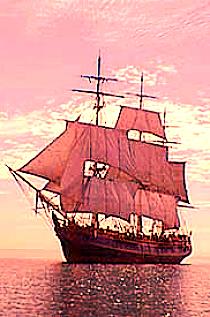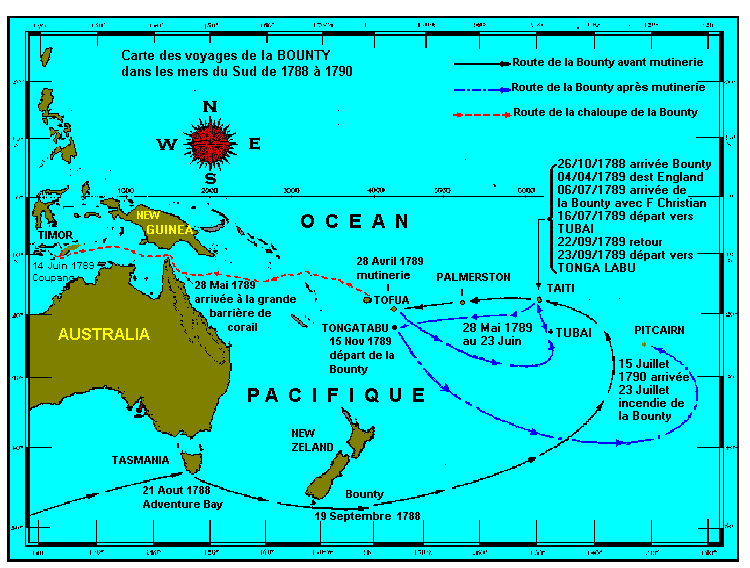
BOUNTY STORY
|
Le 28 avril 1789 en route pour les Caraïbes, Fletcher Christian premier Maître et Ned Young quartier
Maître déclenchaient une mutinerie à bord de la Bounty. Les Mutins laissèrent le Capitaine William Bligh et 18 des membres
de l'équipage à bord de la chaloupe dans l'archipel des îles Tonga. Au terme d'un terrible et long voyage de 42 jours sur
3500 miles ils arrivèrent sains et saufs à Coupang dans l'île de Timor. Après un voyage épique de 8000 miles dans le
Pacifique à la recherche d'un havre de paix et de sécurité, les mutins trouvèrent finalement refuge en 1790 dans l'île de
PITCAIRN où ils déchargèrent les provisions et les équipements du navire qui fût ensuite brûlé.
|
 |
On 28 april 1789 on route to the Caribbeans Master Mate Fletcher Christian and Midshipman Ned Young led a mutiny aboard
H.M.S.Bounty. The Mutineers set Captain William Bligh and 18 of his crew adrift in the ship's launch off Tonga islands.
They reached the Island of TIMOR after a terrible voyage of 3,500 miles lasting 42 days. The mutineers after an epic
8,000 mile Pacific voyage in search of a haven, finally found refuge in 1790 on the Island of PITCAIRN where
they unloaded the ship's provisions and then burned her.
|
Quelle était l'étrange mission de la Bounty ? et pourquoi cette mutinerie ? Je m'en vais vous narrer succintement cette
passionnante histoire, qui a donné lieu à pas moins de six films et plusieurs milliers de livres et publications!
But what was the strange Bounty's mission ? and what was the origine of the mutiny ? I am going to tell you this
thrilling story...
Un peu d'histoire / A little bit of history. Au dix-huitième siècle la révolution Américaine mit fin à un
commerce triangulaire très lucratif et bien installé qui fonctionnait de la manière suivante. Philadelphie, New York et
d'autre ports d'Amérique du nord embarquaient des centaines de quintaux de farine à destination de la Jamaique, de la
barbade et d'autres iles productrices de canne à sucre, afin de nourrir les esclaves des plantations. En échange les
armateurs obtenaient du sucre et du rhum à destination du royaume uni où ils réambarquaient des produits manufacturés à
destination des ports d'origine. Les Anglais à la fin de la guerre civile dénoncèrent ce protocole à la réprobation des
Américains et des planteurs de canne qui éprouvèrent des difficultés à trouver de nouvelles sources d'approvisionnement
pour nourrir leurs esclaves. Le Capitaine Cook lors de son premier voyage dans le Pacifique avec l'Endavour découvrit
une solution possible. Joseph Banks botaniste qui participait à l'expédition attira son attention sur les fruits de
l'arbre à pain dont la pulpe farineuse à chair blancheâtre se comportait sensiblement à la cuisson comme notre pâte à
pain. Plusieurs membres du gouvernement furent séduits par cette théorie et on décida d'envoyer un bateau à Taiti pour
ramener un millier de jeunes plans d'arbre à pain afin de les implanter dans les Caraïbes.
In eighteenth Century the American Revolution had broken up a profitable and long standing triangular trade in which,
among other things, Philadelphia, New York, and other North American ports sent flour to feed the slaves in Jamaica,
Barbados, and other sugar islands, getting in exchange sugar and rum, which could be exchanged for British manufactures.
The British, at the close of the war, put an end to that arrangement, to the distress of the Americans and even more so
to the sugar islands, where slave holders found it difficult to feed their slaves.
From Captain John Cook's first Pacific voyage in the Endeavor came a suggestion of possible relief. Joseph Banks
(later Sir Joseph), the wealthy naturalist who went on the voyage, called attention to breadfruit, the inside of which
could be a good substitute for bread. He pulled government wires, at which he was most adept, and gained authorization
for sending a naval vessel out to Tahiti to take a thousand or so young breadfruit plants to feed the West Indian slaves.
L'histoire de la Bounty première partie / Bounty's story first part.
La marine royale acheta un petit trois mâts appelé Bethia rebaptisé Bounty, on l'amena à Depford le 26 Mai 1787 pour
l'équiper spécialement en vue de l'expédition. Le navire jaugeait 215 tonneaux, avec un pont de 90 pieds 10 pouces de
long et 24 pieds 3 pouces de large, armé de quatre canons et de 10 couleuvrines. ( pour comparaison, l'Endeavour jaugeait
368 tonneaux). La transformation commença en Juin 1987 et une grande partie du navire fut transformé en
"jardin flottant", avec un botaniste et un assistant pour veiller sur la cargaison. En conséquence de ce manque de
place, il n'y avait de cabine pour personne y compris les officiers, excepté le Capitaine. Le lieutenant William Bligh
prit le commandement du navire grace à l'influence des banquiers commanditaires, et la Bounty prit le large de Portsmouth
le 23 Décembre 1787 avec 47 hommes d'équipage à destination de Taiti, là ou le capitaine Cook avait trouvé les arbres à
pain. Après dix mois d'une traversée extrêmement éprouvante sur l'Atlantique et le Pacifique, essuyant une terrible
tempête au cap Horn et nécessitant un changement de direction vers le cap de Bonne espérance, le Capitaine faisant
preuve d'une tyrannie caractérisée envers l'équipage, il entra plusieurs fois en conflit avec Fletcher Christian son
premier Maitre; enfin le navire accosta à Tahiti ou par nécessité il fallut attendre six mois avant de repartir avec
la cargaison de plants d'arbres à pain. Les marins vécurent une merveilleuse période et nombre d'entre-eux trouvèrent
des compagnes indigènes, si bien que lors du départ l'enthousiasme était très limité, de plus les plants d'arbres à pain
nécessitaient beaucoup d'eau et le Capitaine Bligh n'hésita pas à réduire les rations de manière drastique, son
comportement tyrannique prenait des proportions inquiétantes ....
The Bounty small three masted ship, (originally the Bethia) was purchased by the Navy and taken to Deptford for
refitting and supply on 26 May 1787. The Bounty carried four 4-pounders and ten swivels. The ships statistics: 215 tons,
length on deck 90 feet 10 inches breadth 24 feet 3 inches. (In comparison Captain Cook's Endeavour weighed 368 tons.)
The refit commenced in June 1787, a large part of the ship was transformed into a "floating green house", with a special
gardener and assistant in charge. One result of the scant space was that no room was available for any marines, who had
the duty of guarding the officers. The command went to Lieutenant William Bligh , partly through the influence of Banks.
The Bounty with a crew of 47 sailed from Portsmouth on December 23, 1787 on a voyage to Taihiti where Captain Cook has
found breadfruit plants. After 10 months of extremely tiring sailing though Atlantic and Pacific Ocean including a
terrible storm on Cape Horn, new rooted to Cape good hope, and several struggle between Master mate Fletcher Christian
and Captain Bligh who acted tyrannically with crew, the Bounty reached Taihiti. There Captain Bligh found he would have
to wait 6 months before he could embark his cargo, so the crew enjoyed a wonderful life ashore on the island where seamen
met native women. When the order was given to load up and embark there was little enthusiasm and many problems.
The breadfruit plants need great quantity of water and captain decided to reduce crew's rations, Bligh tyranny was
increasing ....

La mutinerie et ses conséquences. / Mutiny and the result.
La célèbre mutinerie éclata le 18 avril 1789, dirigée par le premier maitre Fletcher Christian et le maitre d'équipage
Ned Young, le capitaine Bligh ainsi que 18 fidèles membres de l'équipage furent embarqués à bord de la chaloupe avec
seulement 150 livres de biscuits, vingt livres de viande salée, 120 livres d'eau, un compas et un sextant et laissés
aux environ de l'archipel des TIMOR (peuplés de cannibales). Avec un extrême courage et contre toutes épreuves le
capitaine Bligh et ses compagnons d'infortune atteignirent le port de Coupang dans l'Ile de Timor, après un voyage de
3500 miles qui avait duré 42 jours. Les mutinés reprirent la direction de Tahiti ou ils rembarquèrent avec 36 indigènes
( 19 femmes, 6 hommes et un bébé). Les nouveaux embarqués commencèrent à se quereller et neuf d'entre-eux qui ayant
peur d'être retrouvés voulurent repartir avec à leur tête Fletcher Christian. Ils errèrent pendant environ deux mois à
travers le Pacifique sud à la recherche d'une ile inhabitée éloignée des routes maritimes fréquentées.
Après avoir navigué dans les Iles Cook, Tonga, les Fidji orientales, sans avoir trouvé d'endroit susceptible d'assurer
leur sécurité, alors qu'ils perdaient toute confiance, Christian se rappela un repère aperçu sur une carte concernant
l'ile de Pitcairn très peu connue et à l'écart des routes maritimes. Ils mirent le jour même le cap sur cette terre
promise et l'atteignirent au début de l'année 1790, le 15 Janvier. Après avoir vidé la Bounty de ses provisions, ils
l'incendièrent. les descendants de Fletcher Christian et de ses compagnons vivent encore aujourdhui sur cette Ile.
Les autres mutins qui avaient choisi de rester à Tahiti furent capturés par le capitaine Bligh et réembarqués vers
l'Angleterre à bord du H.M.S. Pandora, Ils furent traduits en cour Martiale.
On 18th April 1789, the notorious mutiny broke out on board, led by Masters Mate Fletcher Christian and Midshipman
Ned Young, Captain Bligh and 18 loyal members of his crew were set adrift off Tonga Islands in the ship's launch, with
150 pounds of biscuit, 20 pounds of salt meat, 120 liters of water, the ship's log, a compass and sextant. Against all
odds with this crew, Captain Bligh reached the Island of TIMOR after a voyage of 3,500 miles lasting 42 days.
The mutinous crew sailed to Tahiti where twentysix natives (nineteen women, six men and one baby) were taken on board.
The members of the crew began to quarrel, so nine of them, afraid to be discovered and jailed, sailed away, leaving
the other ones in Tahiti. Once again Christian was the leader. They wandered for over two months across the south
Pacific, looking for an uninhabited island far from every known route. They routed to Cook Islands, Tonga, the eastern
Fiji Islands, without meeting any safe place to settle down. Before losing hope, Christian remembered an old report by
a Carteret, mentioning the Island of Pitcairn. They immediately rooted toward their "promised land" and reached it at
the beginning of 1790, exactly on January, 15th. They unloaded the ship's provisions and then burned her.
The descendants of Fletcher Christian and his fellows live in Pitcairn today. The Mutineers who elected to stay at
Tahiti were captured by Captain Bligh and were to sail back to England on board H.M.S. Pandora where they were to face
Court Martial.
Last Revised on Oct 19 2005 / Dernière mise à jour: 19 Oct 2005





